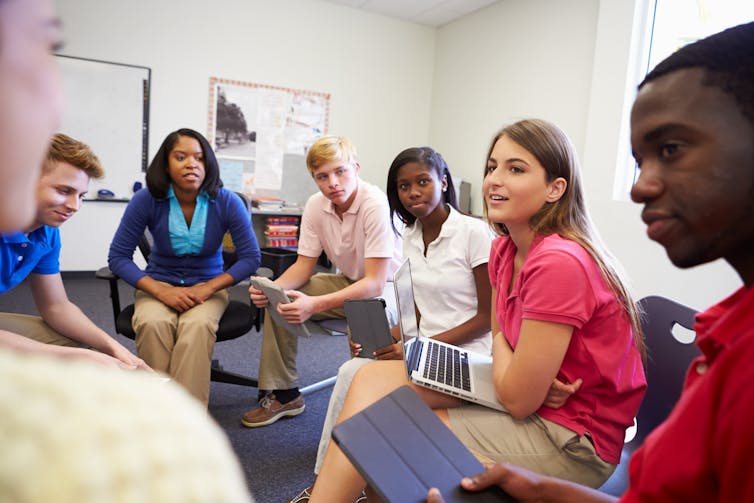
It’s now over a year since 33-year-old Sarah Everard was kidnapped while she walked home and killed by a police officer in London. Since then, we’ve also seen the case of Sabina Nessa, a primary school teacher also from London, was also killed by a stranger while walking to meet a friend. And in early 2022 in Tullamore, Ireland, 23-year-old Ashling Murphy was killed when out for a run in a public place in daylight hours.
The problem of violence against women might seem insurmountable. But focusing on education about misogyny may provide a place to start. In particular, it is important to help young people understand what misogyny is, how it affects both women and men, and how it can lead to violence.
Our research on moral education, sex education and violence against women can help spell out the link between misogyny and violence, and how education can address these issues.
According to the philosopher Kate Manne, misogyny is not “hatred of women”. Instead, it is a set of social rules that enforce a patriarchal society – one where men are dominant and women are subordinate. The essence of misogyny lies in its function, and that function is to keep women down.
Misogyny is deeply rooted in society. Girls are regularly assigned lower social status, while masculinity is associated with power and privilege. In an unequal society it is easier to justify violence committed by the more powerful. Women might be treated with scepticism and not believed, while men might be favoured, and their side of the story deemed more credible.
However, misogyny also affects men. Research suggests that men can suffer from a phenomenon known as “male discrepancy stress” – feelings of distress when they feel they have failed to conform to masculine gender norms.
Male discrepancy stress might come from the idea of being perceived as weak, dependent or emotional. This distress has been linked to male violence against women. When men feel the effects of misogyny, it can have deadly effects upon women.
Educating people about misogyny and its repercussions could be a start in addressing violence against women.
Building identity
Children try to create their own identity, but this can be undermined by gender-based bullying. For instance, a boy who wants to be a nurse when he grows up might suppress this ambition when confronted by the reactions of other children, and instead focus on a more “masculine” career.
At school, children could be encouraged to reflect on how gender stereotypes have affected them – and how, in turn, their own behaviour might constrain their classmates.
Reflection on gender stereotypes can be guided through philosophy. The central idea behind philosophy for children is to facilitate autonomous learners by encouraging students to think for themselves. Starting with a reflection on how easy it is to rely on stereotypical thinking about gender, the teacher could query how useful or harmful such thinking might be.
Doing philosophy with children is known to have beneficial outcomes for children.
Another approach could use the history of philosophy as a starting point. Older students could be introduced to the work of Mary Wollstonecraft (1759-1797), the so called “mother of feminism” and a ferocious critic of stereotypical notions of femininity.
However, philosophers have often questioned whether the mother of feminism was herself a misogynist. Students could look at how Wollstonecraft herself may have perpetuated gender norms by accusing fellow philosopher Edmund Burke of not being masculine enough.

Participatory research methods, where young people actively “do the research”, may be a good way to change perspectives. Two Irish school students, Cormac Harris and Alan O’Sullivan. conducted a project on gender bias in the classroom and won top prize at the 32nd European Union Contest for Young Scientists.
Harris and O'Sullivan investigated the prevalence of gender stereotypes in children aged from five to seven. They found that gender stereotyping was particularly prevalent among boys, and that boys are less willing to recognise female ability. To combat gender stereotyping, they have gathered resources to be used by teachers and parents that explicitly target gender bias.
Sex education classes can also provide a venue for students to learn about the importance of caring for the other person in a relationship and focusing on their wellbeing when discussing relationships. By incorporating issues of consent and partner violence, these classes can help to prevent misogyny and promote equality between genders.
This type of teaching could help give students a reflective distance from stereotypes, providing them with mental resources which may help when such stereotypes are used against them. In this way, perhaps, teaching could be used in the combat against gender inequality and male discrepancy stress.
The authors do not work for, consult, own shares in or receive funding from any company or organisation that would benefit from this article, and have disclosed no relevant affiliations beyond their academic appointment.
This article was originally published on The Conversation. Read the original article.







